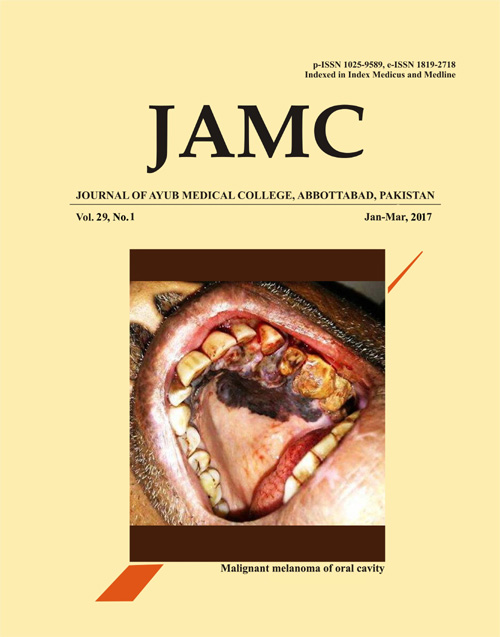EXPLORATION OF THE CONTRALATERAL GROIN IN PAEDIATRIC INGUINAL HERNIA OR HYDROCELE BASED ON ULTRASOUND FINDINGS – IS IT JUSTIFIED?
Abstract
Background: Routine exploration of contralateral side in cases of unilateral inguinal hernia or hydrocele is a highly debatable topic because of various reasons. The purpose of this study was to analyse whether the contralateral groin exploration in unilateral inguinal hernia/ hydrocele is justified or not, based on ultrasonographic measurements of the inguinal ring diameter. Methods: This cross-sectional study was conducted at two naval hospitals, PNS Rahat and PNS Shifa in Karachi, Pakistan, from June 2007 to Aug 2012. Children presenting with unilateral inguinal hernia or hydrocele were included in the study. Ultrasound examination of the contralateral, apparently normal, groin was carried out using a high-resolution 7.5-11 MHz linear array with the patients in supine position. Surgical exploration of the contralateral groin was carried out in those children in whom the diameter of the inguinal canal at the internal ring was 4.5 mm or greater. All those children in whom the contralateral exploration was not done were followed up to 2 years. Results: A total of 287 patients completed the study, including 264 (92%) boys and 23 (8%) girls. In 242 (84%) cases, the mean diameter of internal ring on contralateral (clinically uninvolved) side was 3.5± 0.4 mm, considered negative. Out of these 13 (5.4%) cases, however, proved to be false negative after a follow up of two year. There were 45 (16%) cases that underwent contralateral exploration on basis on positive ultrasound findings; 25 (55.6%) were hernias and 14 (31.1%) were hydroceles. In the remaining 6 (13.3%) cases surgical exploration failed to demonstrate hernia or PPV. Conclusion: Contralateral exploration in children with unilateral inguinal hernia or hydrocele, based on ultrasonographic findings, is not only cost effective but can also prevent unnecessary routine contralateral explorations and complications related to inguinal hernias.Keywords: Inguinal hernia; Patent process vaginalis; Hydrocele; Contralateral exploration; Ultrasonography; Internal ring diameterReferences
Row MI, Marchildon MB: Inguinal hernia and hydrocele in infants and children. Surg Clin North Am 1981;61(5):1137–45.
Rowe MI, Clatworthy HW Jr. The other side of the pediatric Inguinal hernia. Surg Clin North Am 1971;51(6):1371–76.
Maillet OP, Garnier S, Dadure C, Bringuier S, Podevin G, Arnaud A, et al. Inguinal hernia in premature boys: should we systematically explore the contralateral side? J Pediatr Surg 2014;49(9):1419–23. Ref no 3&11 are same
Glick PL, Boulanger SC. Inguinal hernias and hydroceles. In: Grosfeld JL, O’Neil JA, Fonkalsrud EW, Coran AG, editors. Pediatric Surgery. 6th ed. Philadelphia: PA. Mosby; 2006. p.1180–2.
Kapur P, Caty M, Glick P: Pediatric Hernias and hydroceles. In Glick P, Irish M, Caty M, eds: The Peediatric Clinics of North America. Philadelphia, WB Saunders, 1998, pp773-789.
Klin B, Efrati Y, Abu-Kishk I, Stolero S, Lotan G. The contribution of intraoperative transinguinal laparoscopic examination of the contralateral side to the repair of inguinal hernias in children. World J Pediatr 2010;6(2):119–24.
Hashish AA, Mashaly EM. Ultrasonographic Diagnosis of Potential Contralateral Inguinal Hernia in Children. Ann Pediatr Surg 2006;2(1):19–23.
Hata S, Takahashi Y, Nakamura T, Suzuki R, Kitada M, Shimano T. Preoperative sonographic evaluation is a useful method of detecting contralateral patent processusvaginalis in pediatric patients with unilateral inguinal hernia. J Pediatr Surg 2004;39(9):1396–9.
Shehata SM, Ebeid AE, Khalifa OM, Noor FM, Noomaan AA. Prospective comparative assessment of ultrasonography and laparoscopy for contralateral patent processusvaginalis in inguinal hernia presented in the first year of life. Ann Pediatr Surg 2013;9(1):6–10.
Miltenburg DM, Nuchtern JG, Jaksic T, Kozinetz CA, Brandt ML Meta-analysis of the risk of metachronous hernia in infants and children. Am J Surg 1997;174(6):741–4.
11Toki A, Watanabe Y, Sasaki K, Tani M, Ogura K, Wang Z-Q, et al. Ultrasonographic diagnosis for potential contralateral inguinal hernia in children. J Pediatr Surg 2003;38(2):224–6.
12Toki A, Ogura K, Miyauchi A. Ultrasonographic diagnosis of inguinal hernia in children. Pediatr Surg Int 1995;10(8):541–3.
13Miltenburg DM, Nuchtern JG, Jaksic T, Kozinetiz C, Brandt ML. Laparoscopic evaluation of the pediatric inguinal hernia - a meta-analysis. J Pediatr Surg 1998;33(6):874–9.
14Duharme JC, Guttman FM, Plijak M. Hematoma of bowel and cellulites of the abdominal wall complicating herniography. J Pediatr Surg 1980;15(3):318–9.
Published
Issue
Section
License
Journal of Ayub Medical College, Abbottabad is an OPEN ACCESS JOURNAL which means that all content is FREELY available without charge to all users whether registered with the journal or not. The work published by J Ayub Med Coll Abbottabad is licensed and distributed under the creative commons License CC BY ND Attribution-NoDerivs. Material printed in this journal is OPEN to access, and are FREE for use in academic and research work with proper citation. J Ayub Med Coll Abbottabad accepts only original material for publication with the understanding that except for abstracts, no part of the data has been published or will be submitted for publication elsewhere before appearing in J Ayub Med Coll Abbottabad. The Editorial Board of J Ayub Med Coll Abbottabad makes every effort to ensure the accuracy and authenticity of material printed in J Ayub Med Coll Abbottabad. However, conclusions and statements expressed are views of the authors and do not reflect the opinion/policy of J Ayub Med Coll Abbottabad or the Editorial Board.
USERS are allowed to read, download, copy, distribute, print, search, or link to the full texts of the articles, or use them for any other lawful purpose, without asking prior permission from the publisher or the author. This is in accordance with the BOAI definition of open access.
AUTHORS retain the rights of free downloading/unlimited e-print of full text and sharing/disseminating the article without any restriction, by any means including twitter, scholarly collaboration networks such as ResearchGate, Academia.eu, and social media sites such as Twitter, LinkedIn, Google Scholar and any other professional or academic networking site.









